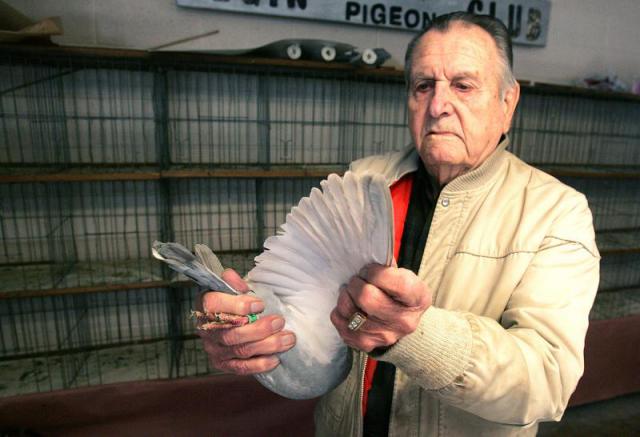Pigeons swoop, dart and soar over and through World War II veteran Ed Schmidt’s life. The birds fascinated him in childhood, determined his job in the military, and pinned his career.
Schmidt’s neighbor growing up, Homer Mann, had pigeons, and as a boy Schmidt was fascinated by them. Though he initially kept his distance, shy, by age 6 he eventually talked to Mann.
“Little by little I got a little braver, I guess. ... And pretty soon I had pigeons,” Schmidt said.
He learned to train them to know where they lived, then would take them away and set them free. Of course, the birds would fly home. Schmidt said scientists are still working to figure out this homing instinct — why and how it works.
By age 10, Schmidt had joined the Elgin Junior Pigeon Club and began racing them.
In the late 1930s, Schmidt and the partner he’d flown pigeons with in high school, Ralph Walker, sent five birds to Denver with greetings to the Illinois governor attached to their legs. The birds were released in the morning and two made it back to Illinois that same day, Schmidt said.
When World War II broke out, Schmidt was drafted into the Army. Looking over his life history, the military decided he would be best used for his pigeoneering skills. He was stationed in Hawaii, where he worked with the 279th “Fighting Pigeoneers,” as part of the signal corps, to train Racing Homer pigeons as military messengers.
In the era on the cusp of electric communication, just before the advent of television and decades before even kids would send instant text messages or video across the world at the touch of a screen, pigeons provided more reliable messenger service than electricity offered. Schmidt said an electric message would be stopped by mountains, so all countries used the birds as service animals.
“(The birds were) very important. Like I say they were more than 99 percent successful in getting messages back — even through the enemy lines,” Schmidt said. “They got back from places where radio and telephone wouldn’t work.”
After the birds are born, Schmidt said, they stay in their nests for about three weeks before they’re taken out and weened. As they get settled, “they’ll get up and fly as a group. They may be gone for an hour or so —routing. They’re learning their territories,” he said.
The pigeoneers, their trainers, would take the birds away from the territory they’d established as home — whether that was headquarters in the case of Hawaii, or the front lines, stuffing 35 or 40 in the back of an Army pickup, hauling them off, and incrementally increasing the distance over time.
Small identification bands snapped around the birds’ legs allowed soldiers to attach capsules with messages in them. Schmidt said the birds could deliver messages as short a distance as a few miles and regularly up to 50 or 60 miles or more. He said their average speed, taking weather into account, was about 50 miles an hour.
They’d always find their way back, Schmidt said, and the military counted on this hyper-accuracy.
So much so that pigeons became targets, especially in the European Theatre, Schmidt said. (In Hawaii, where he served, he said there wasn’t much action.)
“The Germans shot ours down, and we shot the Germans’ down,” he said. This led to a practice of releasing a couple pigeons with the same message to ensure at least one made it.
Of his time in service, Schmidt said the men fill his favorite memories, the interactions of different personalities. He said he’s good with pigeons because he’s a “people person.” Dealing with pigeons can be a lot like dealing with people, he said.
“Pigeons have a personality and so do people, and they’re all different. ... Each one is an individual like anything else, like dogs or horses or anything else. We’ve all got a personality. Some are good, some are bad.”
A pigeon from his time in service, Lady, proved to be a favorite personality. After the Army, he brought her home with him. Though she was at the base, she was never used for military purposes.
“She was my pet. She could do anything,” he said. Her best trick: let out of her cage, she’d perch on Schmidt’s shoulder. “She was different from the rest. ... She was my buddy.”
When he returned home, a chance to fill in as an auctioneer came his way because of his experience with pigeons — selling the birds to the highest bidders. His whole career in agricultural commodities, he auctioneered on the side (not always pigeons), and even appraised pigeons. After retirement, he was able to continue auctioneering — the gig he got thanks to the birds.
His wife, Norma, helped raise and care for the birds, watching after them when Schmidt was on the road. After his wife’s death, he moved to an area of town that doesn’t allow the birds. He’s farmed them out to new owners in Chattanooga, Tenn., and Florida, he said.
But Schmidt continues to work with the birds. He talked about an upcoming pigeon sale he’s auctioneering in Rockford, Ill.
Schmidt will even be featured in an upcoming documentary on the subject, Pigeoneers III, which, according to the movie’s website, will come out this year. (Here’s a link to the film’s website: http://www.pigeonsincombat.com/thepigeoneerswebpage.html.)
“It goes back to these pigeons, they’ve been 99 percent of my life, I guess,” Schmidt said.
(Photo credit: H. Rick Bamman/Northwest Herald)




